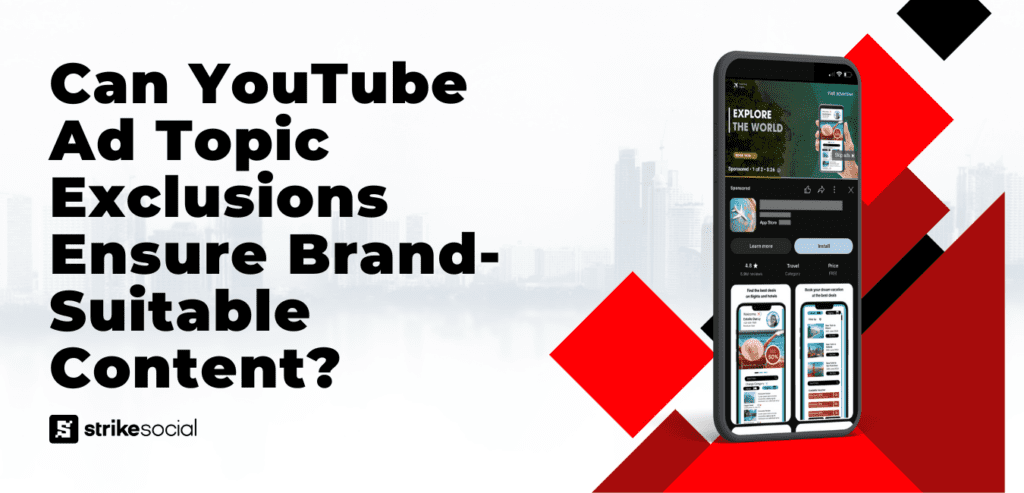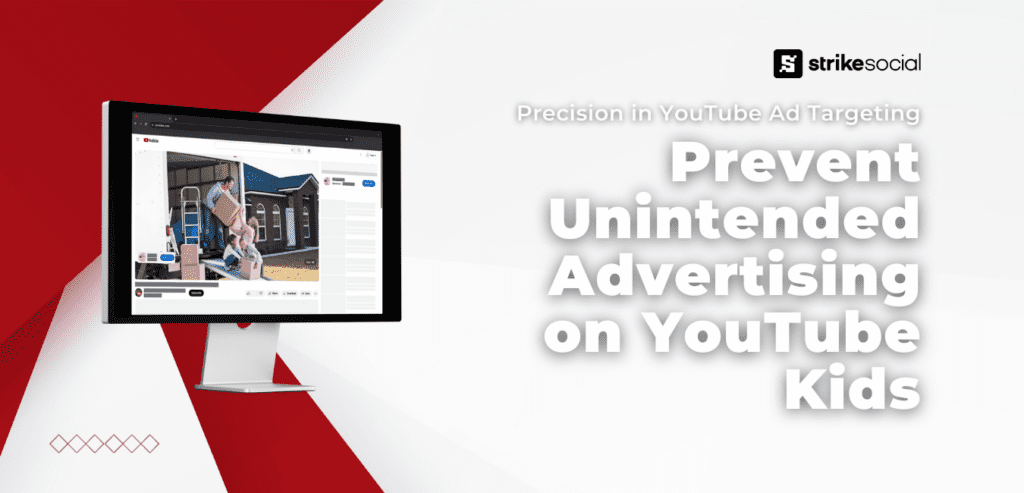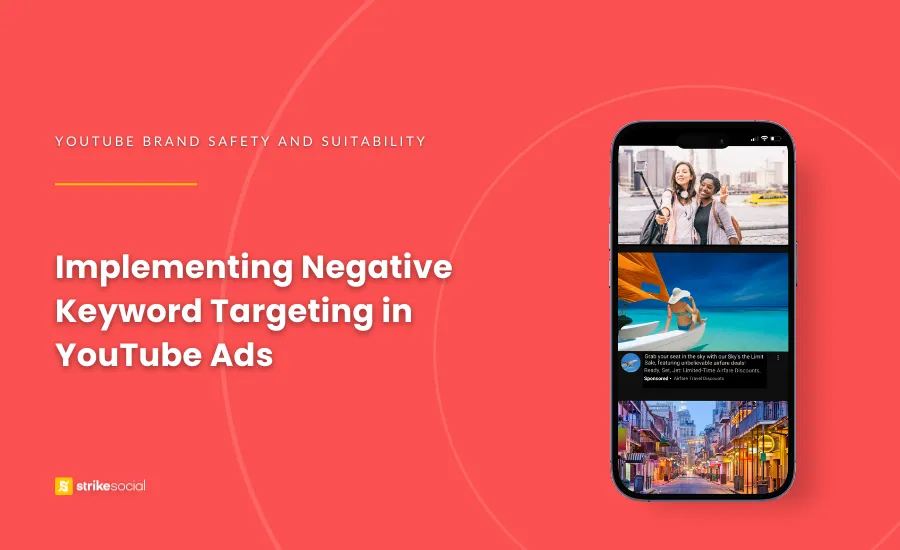Strike Overview
- Did you know that by implementing negative keyword targeting in your YouTube ads, you can maximize your ad spending by up to 90%?
- According to HawkSEM’s study, that’s because you could be getting clicks on your ads meant for similar-sounding but unrelated keywords.
- With negative keyword targeting, brands can avoid having their YouTube advertisements displayed alongside content containing those terms, thus refining their ad targeting and reducing irrelevant impressions.
Jump to Section
Reconnect With Your Target Audience By Implementing Negative Keyword Targeting in YouTube Ads
Achieving success in your YouTube ad campaigns hinges on precision – getting your ads in front of the right eyes and steering clear of the wrong ones. The key players in this strategy are keyword targeting and its counterpart, negative keyword targeting.
Keyword targeting ensures your ads align with specific keywords, placing them alongside relevant content. Conversely, negative keyword targeting in YouTube ads acts as a filter, keeping your brand away from content associated with flagged keywords.
By combining these two tactics, you create a hyper-focused campaign. Your ads reach viewers with shared keyword interests while avoiding those looking for terms that don’t align with your brand. In the following discussion, we’ll uncover how negative keyword targeting works and the benefits it brings to advertisers who leverage a well-defined negative keyword list in their YouTube advertising.
What is Negative Keyword Targeting?
Implementing a negative keyword targeting strategy can be commonly overlooked in advertising efforts. This oversight often stems from advertisers concentrating excessively on where they want their YouTube ads to appear. Yet, it is equally crucial to monitor the type of content with which you don’t want your ads associated. Before going through the intricacies of this strategy, let’s take a step back to comprehend the essence of negative keyword targeting.
Negative Keyword Targeting Defined
Negative keyword targeting was first introduced by Google when it was still known as Google AdWords (later rebranded as Google Ads in 2018). Since then, it has become a standard practice, especially in YouTube advertising.
Google defines a negative keyword in digital marketing as a type of keyword that prevents a certain word or phrase from triggering your ad. Applying negative keywords ensures that your ads are not displayed to anyone searching for that specific phrase.
Why Negative Keyword Targeting Matters
By excluding specific words or phrases, you prevent your video ads from appearing in irrelevant searches. Advertisers can create and utilize negative keyword lists to streamline the process across multiple campaigns.
This process improves your ad targeting in YouTube, ensuring your message reaches those genuinely interested in what you offer. It keeps your ads focused on the right audience, elevating the precision and effectiveness of your YouTube advertising efforts.
Further Reading

Using Topic Exclusions to Avoid Misaligned Content
Topic exclusions help advertisers filter out content categories like news, politics, religion, sensitive regions, crime, and mature themes. These customizable settings enable campaigns to align better with brand values while maintaining flexibility for different objectives.
How to Initiate Your Negative Keyword Strategy in YouTube Advertising
To kick off your negative keyword strategy in YouTube advertising, consider adding these keywords at the campaign or ad group level, depending on what aligns better with your objectives. This guide offers a thorough walkthrough on seamlessly integrating negative keywords into your YouTube ad campaigns:
Campaign Level Negative Keywords
By adding negative keywords at the campaign level, advertisers automatically exclude specified terms from all ads within the campaign.
Ad-group Level Negative Keywords
Advertisers can add negative keywords at the ad-group level for a more focused approach. This allows for tailored exclusions, ensuring that selected ads do not appear with undesirable keyword associations.
Contextual Targeting
You can use negative keyword lists to manage and apply negative keywords across multiple campaigns efficiently. This way, you can select the existing list to apply them to your YouTube advertisements.
Limitations of negative keyword targeting in YouTube ads:
- It’s important to note that negative keywords on the Display Network may not be as precise as on the Search Network. Moreover, a maximum limit of 5,000 negative keywords is allowed as exclusions on your YouTube video ads.
- To further refine your targeting, consider applying content theme exclusions to exclude specific channels and content.
Further Reading

Why Excluding YouTube Kids’ Channel Is A Priority
Protecting your brand’s reputation starts with understanding why it’s crucial to keep your ads off YouTube Kids channels and the advantages of taking this precautionary step.
For a clearer picture, here’s a sample negative keyword targeting list for a luxury watch brand conducting a Winter Collection campaign:

Note: These are sample keywords only. For a more specified negative keyword list, you can utilize Google Bard prompts and prompt it for a negative keywords list that is more aligned with your brand and YouTube advertising strategy.
Need a Head Start? Strike Social Has You Covered.
If you’re unsure about where to begin your negative keyword targeting strategy, Strike Social offers a curated list of 5000+ keywords. This comprehensive list includes terms related to sexual, hot-button, off-color, and NSFW topics. Easily incorporate these keywords at the launch of your campaign for targeted and brand-safe advertising. Get your first 500 keywords here.
Advantages of Negative Keyword Targeting for YouTube Advertisers
Using negative keywords may be counterintuitive. However, the benefits are substantial and can significantly impact the success of your ad campaigns. Here’s a breakdown of why incorporating negative keyword research tools is a smart move:
Elevate Brand Suitability
- A negative keyword list aligns the brand with safe and suitable content, fostering a positive association and avoiding appearances with harmful or undesirable content.
- Strike Social’s brand suitability strategies go beyond just negative keyword targeting. For an overview of the various strategies we employ to ensure brands are aligned with the right content, visit our Strike Social brand safety and suitability guide.
Reduce Wasted Clicks
- Negative keywords enhance click-through rates by ensuring ads appear only for relevant queries.
- Excluding irrelevant search terms minimizes wasted clicks, ensuring ads reach users actively searching for specific keywords, optimizing budget usage.
More Relevant User Experience
- Negative keywords allow you to steer clear of unrelated channels or videos, ensuring your ads are seen by a more relevant audience.
The Positive Effects of Incorporating Negative Keyword Targeting
It’s essential to view negative keyword targeting not as a standalone solution but as a fundamental step in enhancing the suitability of your brand within the platform’s content.
Launching a campaign today is an elaborate process beyond mere clicks and conversions. It demands attention to the positive tone associated with your brand’s visibility. And that’s where negative keyword targeting plays in—a tool in guiding your brand towards positive interactions.
Recognizing and harnessing the positive effects of negative keyword targeting positions your brand for success, ensuring every interaction leaves a favorable impression.








